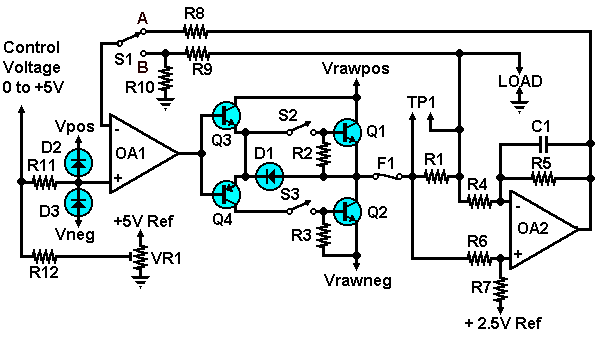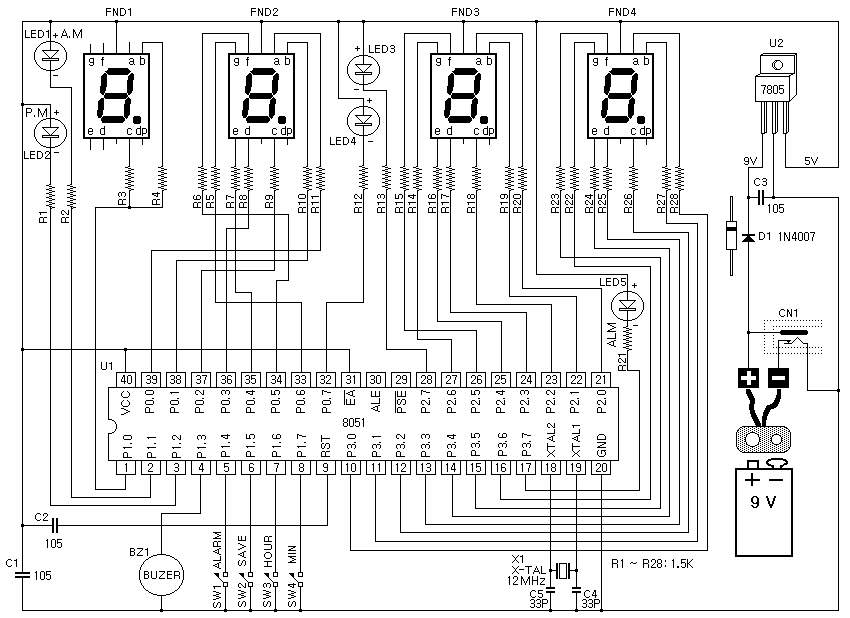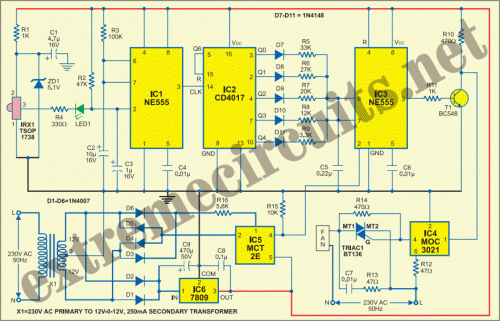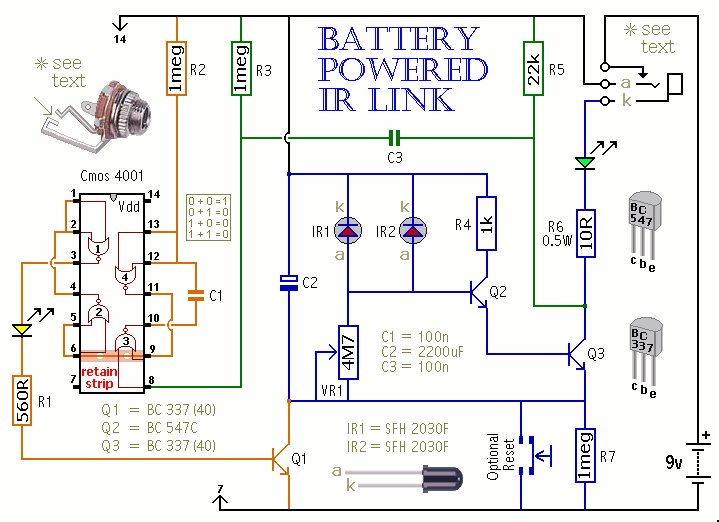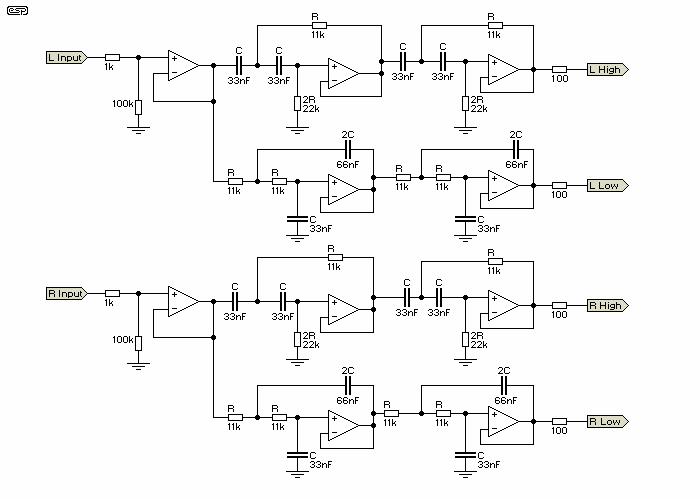
TWO OUADRANT EXPONENTIAL CONTROL
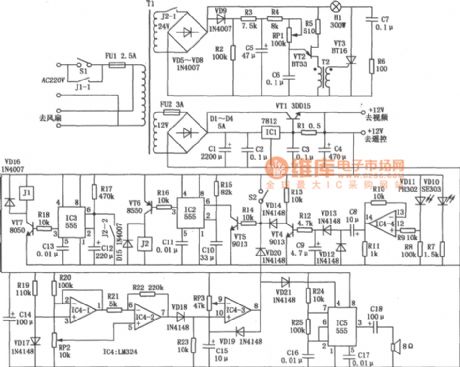
This circuit utilizes a dual operational amplifier (TL082) to create a voltage-controlled oscillator (VCO). The specified component values allow the output frequency to range from 100 Hz to 10 kHz when the input control voltage is between 0.05 and 10 V. The input pulse is directed into a sample-and-hold amplifier (AD582) and a comparator (U3). The output from the sample-and-hold amplifier is also sent to the comparator. If the input pulse's amplitude exceeds that of the sample-and-hold output, the comparator output transitions low, triggering a 10-µs pulse from the 4538 one-shot, which prompts the sample-and-hold amplifier to sample and hold the voltage. Any subsequent input voltages lower than the held value will not re-trigger the one-shot. Gates U4A and U4B manage the sampling inhibition when required. Gates U4C and U4D at the one-shot's output can force the AD582 into sample mode, which is advantageous for resetting the output to zero when the input to the AD582 is zero. The peak-hold circuit's polarity can be easily reversed by swapping the comparator inputs. Additionally, a voltage regulator employs the voltage drop across R3 to sense current draw, activating Q2, which reduces drive to Q1 and lowers the output voltage. Limiting occurs when Q2 experiences 0.65 V across its base-emitter junction, and the circuit exhibits foldback characteristics. The circuit features a duty-cycle generator that can produce outputs ranging from fully off to fully on, as well as pulses of varying duty cycles, employing pulse-width modulation (PWM). It can be powered by any DC supply between 10 to 15 V. A portion of an LM556 dual oscillator/timer and a quarter of an LM339 quad comparator work together to create a voltage-to-pulse-width converter. The first half of the dual oscillator/timer (U1-a) is configured as an astable oscillator, generating a continuous ramp voltage. Op-amp U2-a compares the voltage at its non-inverting input (pin 5) with the voltage at its inverting input (pin 4). The op-amp generates a low output when R1's wiper voltage exceeds the instantaneous voltage at pins 2 and 6 of U1-a. The output of U2-a at pin 2 has an on/off ratio proportional to the voltage at R1's wiper. This output is buffered through U1-b, with the low-impedance pulsed output at pin 9 driving the gate of MOSFET Q1. Additionally, the circuit includes a power-input detector based around U2-b and LED1, which turns off LED1 when the input power is adequate. Diode D1 suppresses reverse voltage spikes generated by inductive loads during turn-off; without this diode, the MOSFET could be damaged. If the circuit is not intended for driving inductive loads, D1 can be omitted. A common collector amplifier drives a 2N3904 switch to activate alarm BZ1. The circuit connects to water sensors or sump pits, level switches, etc., and is designed to be mounted in a dry location. This circuit allows for variable power delivery to a 120-Vac load under software control. A 68705 microcontroller manages eight discrete power triacs, each providing power in 82 smoothly graduated steps, from 0 to 97% of full power. Each channel's power delivery is independent of the others. The power level is adjusted through software rather than using a potentiometer. The software includes fundamental routines for processing interrupts and setting power levels, alongside five test and demonstration routines to evaluate the circuit's performance. There is ample capacity to incorporate additional routines into the built-in EPROM of the 68705 microcontroller.This circuit uses a dual operational amplifier (TL082) to form a voltage-controlled oscillator (VCO). With the component values shown, the output-frequency range is 100 Hz to 10 kHz when the input control voltage is between 0.
05 and 10 V. (View) The input pulse is fed into the sample-and-hold amplifier (an inexpensive AD582), as well as the compa rator U3. The SHA`s output also is fed into the comparator. If the input pulse is higher in am-plitude than the SHA`s output, the comparator output goes low and the 4538 one-shot produces a l0-ps pulse that is fed back to cause the SHA to sample and then hold the voltage. Subsequent input voltages that are less than the held value won`t cause the one-shot to fire again. Gates U4A and U4B are used to inhibit the sampling when necessary. Gates U4C and U4D, at the one-shot`s output, can force the AD 582 into the sample mode. This feature is useful to reset the output to zero by forcing a sample when the input to the AD582 is zero.
The polarity of the peak-hold circuit can be easily changed from positive-to-negative peak hold by reversing the inputs of the comparator. (View) This regulator uses the drop across R3 to sense current draw, turning on Q2, removing drive from Q1, and lowering the output voltage.
Limiting occurs when Q2 has 0. 65 V across the base-emitter junction. This circuit has foldback characteristics as seen from the figure. (View) The circuit has a duty-cycle generator that will produce an output varytng from fully off to fully on and pulses of any duty cycle in between the two extremes. This method of operation is called PWM (pulse zuidth moduhtion) The circuit can be fed fromany dc supply source of between 10 to 15 V Half of an LM556 dual oscillator timer and U2 a(1/4 of an LM339 quad comparator) combine to form a voltage to-pulse-width converter The first half of thedual os dilator/timer(U1-a) is configured as an astable oscillator generating a continuously oscillating ramp voltage Op amp U2-a compares the voltage at its noninverting input (pin 5) ”which is connected to pins 2 and 6 of U1-a ”to the voltage at its inverting input(pin 4) The op amp will producea low output f R1`s wiper voltage lb higher than the instantaneous voltage that is present at pins 2 and 6 of U1-a The output of U2-a at pin 2 will have an on/off ratio that is proportional to the voltageat R1 ‡s wiper.
The output of U2-a is fed to U1-b which is used to buffer the signal The low impedance pulsedoutput of U1-b at pin 9 is fed to the gate of MOSFET Q1 driving it on or off The circuit also has apower-input detector built around U2-band and LED1. If the input power is OK LED1 will shut off. Diode D1 is used to Suppress the reverse voltage spikes that are generated by inductive loads during turn off ›without that diode the MOSFET might be destroyed If the circuit will not be usedto drive inductive loads(motors) D1 can be eliminated.
(View) A common collector amplifier drives a 2N3904 switch to sound alarm BZ1. The wire leads to wa-ter sensor or surnp pit, level switch, etc. and used to allow the alarm to operate and be mounted in a dry place. (View) This circuit is used to vary the power delivered to a 120-Vac load under software control. A 68705 micro controller can control eight discrete power triacs, each of which delivers power in 82 smoothly graduated steps, ranging from 0 to 97% of full power. The value delivered to one channel is independent of the value delivered to any other channel. Loads can include light displays, universal motors, heaters, and other appliances. The power level is set by software, not a potentiometer. The software includes a basic set of routines for processing interrupts and setting the power level. The software also includes five test and demonqtration routines for putting the circuit through its paces.
Moreover, there`s plenty of room to add your own routines to the 68705`s built-in EPROM. The basic circuit 🔗 External reference
05 and 10 V. (View) The input pulse is fed into the sample-and-hold amplifier (an inexpensive AD582), as well as the compa rator U3. The SHA`s output also is fed into the comparator. If the input pulse is higher in am-plitude than the SHA`s output, the comparator output goes low and the 4538 one-shot produces a l0-ps pulse that is fed back to cause the SHA to sample and then hold the voltage. Subsequent input voltages that are less than the held value won`t cause the one-shot to fire again. Gates U4A and U4B are used to inhibit the sampling when necessary. Gates U4C and U4D, at the one-shot`s output, can force the AD 582 into the sample mode. This feature is useful to reset the output to zero by forcing a sample when the input to the AD582 is zero.
The polarity of the peak-hold circuit can be easily changed from positive-to-negative peak hold by reversing the inputs of the comparator. (View) This regulator uses the drop across R3 to sense current draw, turning on Q2, removing drive from Q1, and lowering the output voltage.
Limiting occurs when Q2 has 0. 65 V across the base-emitter junction. This circuit has foldback characteristics as seen from the figure. (View) The circuit has a duty-cycle generator that will produce an output varytng from fully off to fully on and pulses of any duty cycle in between the two extremes. This method of operation is called PWM (pulse zuidth moduhtion) The circuit can be fed fromany dc supply source of between 10 to 15 V Half of an LM556 dual oscillator timer and U2 a(1/4 of an LM339 quad comparator) combine to form a voltage to-pulse-width converter The first half of thedual os dilator/timer(U1-a) is configured as an astable oscillator generating a continuously oscillating ramp voltage Op amp U2-a compares the voltage at its noninverting input (pin 5) ”which is connected to pins 2 and 6 of U1-a ”to the voltage at its inverting input(pin 4) The op amp will producea low output f R1`s wiper voltage lb higher than the instantaneous voltage that is present at pins 2 and 6 of U1-a The output of U2-a at pin 2 will have an on/off ratio that is proportional to the voltageat R1 ‡s wiper.
The output of U2-a is fed to U1-b which is used to buffer the signal The low impedance pulsedoutput of U1-b at pin 9 is fed to the gate of MOSFET Q1 driving it on or off The circuit also has apower-input detector built around U2-band and LED1. If the input power is OK LED1 will shut off. Diode D1 is used to Suppress the reverse voltage spikes that are generated by inductive loads during turn off ›without that diode the MOSFET might be destroyed If the circuit will not be usedto drive inductive loads(motors) D1 can be eliminated.
(View) A common collector amplifier drives a 2N3904 switch to sound alarm BZ1. The wire leads to wa-ter sensor or surnp pit, level switch, etc. and used to allow the alarm to operate and be mounted in a dry place. (View) This circuit is used to vary the power delivered to a 120-Vac load under software control. A 68705 micro controller can control eight discrete power triacs, each of which delivers power in 82 smoothly graduated steps, ranging from 0 to 97% of full power. The value delivered to one channel is independent of the value delivered to any other channel. Loads can include light displays, universal motors, heaters, and other appliances. The power level is set by software, not a potentiometer. The software includes a basic set of routines for processing interrupts and setting the power level. The software also includes five test and demonqtration routines for putting the circuit through its paces.
Moreover, there`s plenty of room to add your own routines to the 68705`s built-in EPROM. The basic circuit 🔗 External reference

